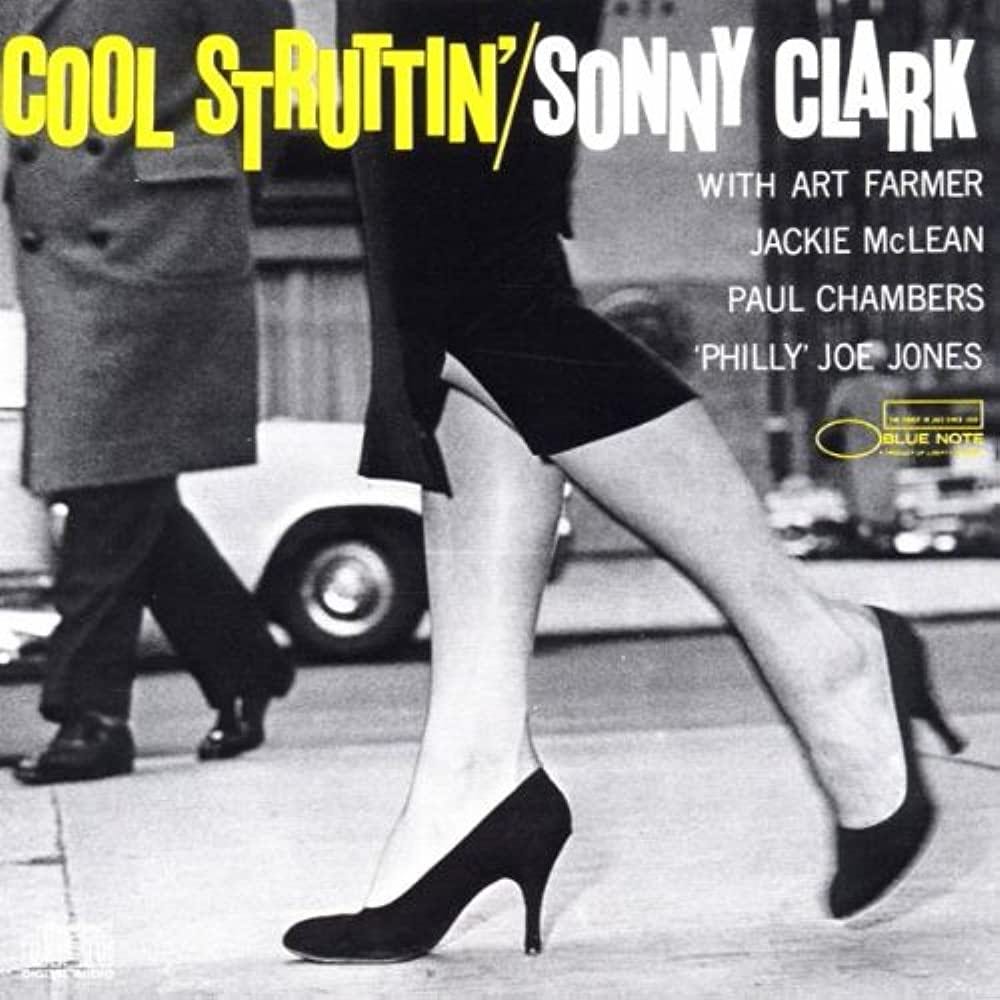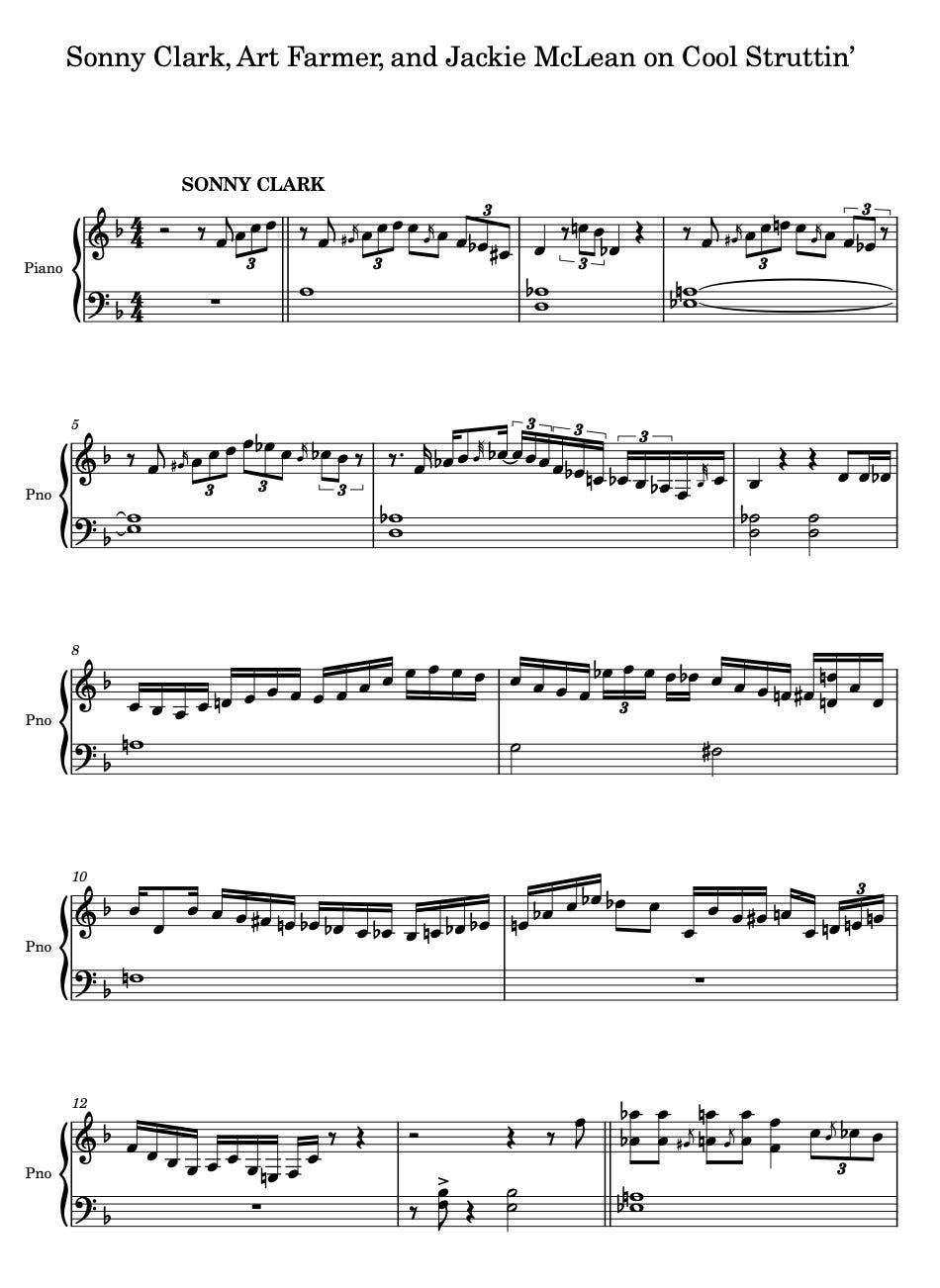TT 259: Transcription of Sonny Clark, Art Farmer, and Jackie McLean on "Cool Struttin'"
And: Why do famous soloists play Behind the Beat?
The title track from Cool Struttin’ is perfect.
Sonny Clark’s blues features Art Farmer, Jackie McLean, Paul Chambers, and Philly Joe Jones; it was recorded on January 5, 1958.
Audio of the piano, trumpet, and alto choruses:
Transcription:
Charlie Parker is very much the patron saint of this music. All three soloists mix virtuosic double-time bebop runs with phrases of pure blues. While every major jazz artist has their own private blues idiom, each and every snaking sixteenth-note line on the five pages above is essentially straight from Bird.
Another blues in F recorded on Cool Struttin’ is by Charlie Parker, “Sippin’ at Bells.” In the liner notes, Sonny Clark says, “I never had the opportunity to play with Charlie Parker. I did meet him once in 1954 in Chicago…Bird encouraged me to continue playing.”
One of Bird’s blues pieces at the “Cool Struttin’” tempo is “K.C. Blues,” recorded in 1951 with Miles Davis, Walter Bishop, Teddy Kotick, and Max Roach. Bird is in inspired form, Miles sounds great as well, but the band is comparatively conservative behind the soloists. The seven years between 1951 and 1958 saw supersonic growth for the rhythm section. On “Cool Struttin,’” Clark, Chambers, and Jones are seriously commanding, mixing up the time feel from “in 2” to “in 4” to shuffle, dealing out the most immaculate and interactive swing. Sonny Clark’s comping is something else. He and Philly Joe Jones really understood each other.
Like Bird on “K.C. Blues,” the “Cool Struttin’” soloists Clark, Farmer and McLean put their melodies — especially the blues melodies — behind the beat. If one could somehow play these solos correctly against a metronomic click into a notation program, the computer would return complex rhythms almost impossible to read.
Is there any reason jazz solos of this era are frequently floating behind the pulse of the rhythm section?
I’ve heard the cover photo of Cool Struttin’ described as sexist, which is probably fair. In the liner notes Clark says the piece was inspired by Clark’s wife, and the legs in the photo belong to Ruth Lion, the second wife of the owner/producer of Blue Note Records, Alfred Lion. Obviously, the legs are “strutting” like the title suggests, and the tempo of Clark’s blues is definitely at a “stroll.”
Charles McPherson has some remarkable insights.
Ethan Iverson: Ok, last question: What about the blues?
Charles McPherson: The real vibe of the blues — a slow blues, not an uptempo blues — is a state of reverence. The Greeks had different words for different kinds of love. “Eros” is sexual love. “Agape” is more how you feel about God.
In the blues, even though there’s plenty of suggestive lyrics, the feeling underneath is more Agape. There’s a longing towards God. You have to be in that kind of space to play the blues well.
“Longing towards God” is an attractive phrase.
One must submit to a divinity.
Perhaps there is a shock, a pause, an intake of breath when confronted with God — or, as in the case of so many suggestive jazz pieces, confronted with a beautiful woman.
Perhaps God and beauty are really part of the same generative force of all life.
Playing the blues melodies behind the beat may simply be a way to register genuine awe. First you pause in shock...and then you proceed, digging in, vibrant, Agape…just like Sonny Clark, Art Farmer, and Jackie McLean.









[Footnote]
Encyclopedia Britannica on Agape: "In John 3:16, a verse that is often described as a summary of the Gospel message, agape is the word used for the love that moved God to send his only son for the world’s redemption. The term necessarily extends to the love of one’s fellow humans, as the reciprocal love between God and humans is made manifest in one’s unselfish love of others."
“Agape” love and a mouth hanging “agape” with incredulity are not the same thing, nor are they pronounced the same way, but they must be related. (I spent some time trying to make that wordplay work in the essay)
This point about blues and playing behind the beat is one of the most perceptive observations I’ve ever heard about the music. I’ll be stealing this, beginning today. Thanks for posting this!